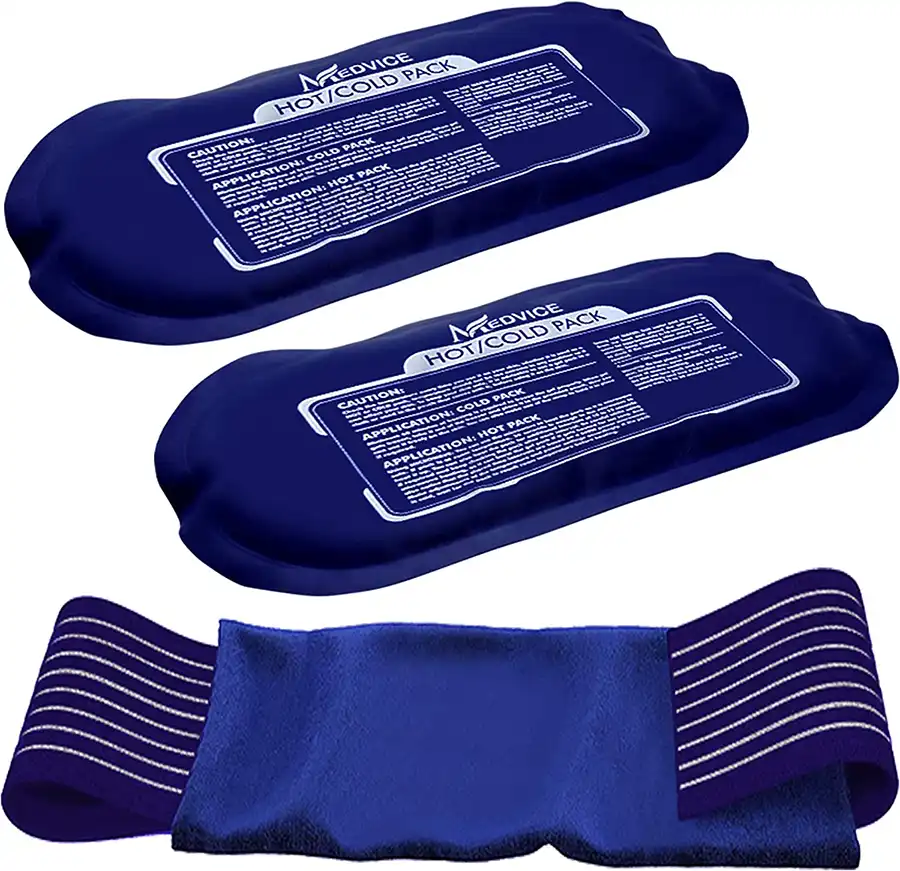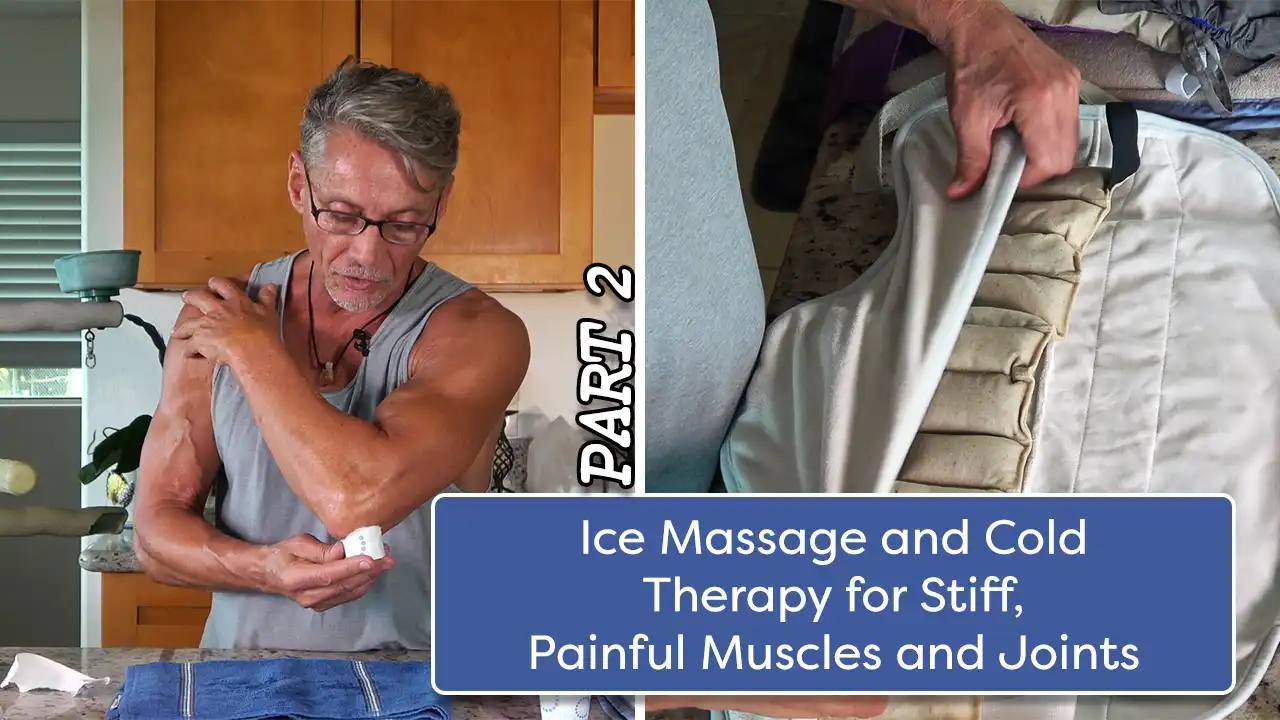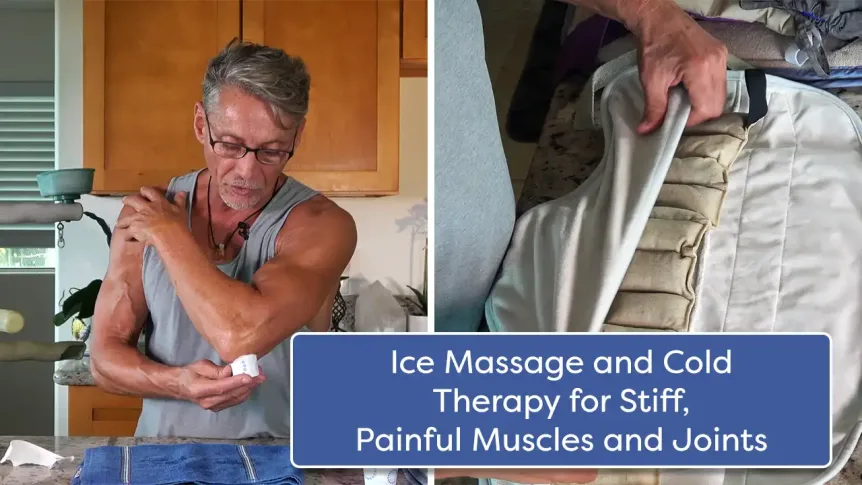Table of Contents
I am going to show you the super easy and the very effective home therapies I have learned for decreasing pain, stiffness, acute swelling and inflammation using a few methods of proven physical therapies.
Quick Note: I have been a practicing Doctor of Chiropractic medicine since I graduated in April, 1984, along with degrees specializing in advanced physical therapies and x-ray diagnostic medicine.
In my extensive clinical practice, which spans 14 years and involves tens of thousands of patients, I’ve seen firsthand the efficacy of these specific therapies. When used correctly, they can be highly effective. However, it’s crucial to note that incorrect application can not only result in a lack of benefit but may even exacerbate symptoms such as inflammation or spasms.
In our expansive physical therapy room, we had the capacity to accommodate 15 to 20 patients simultaneously. We utilized state-of-the-art physical therapy modalities, leveraging the most advanced techniques available at the time. This approach allowed us to thoroughly determine the most effective therapies for various types of injuries. We gained insights into the frequencies of treatments that were most effective for acute and chronic conditions affecting muscles, joints, tendons, and the musculoskeletal system as a whole.
One of the many protocols I am going to show you is called “Ice Massage”. In this course I will show you several ways to use ice/cold therapy on acute and chronic injuries.
I am sure you have used a regular ice pack a few times in your life for a sprain or injury before, but I am also sure that you probably have never tried “Ice Massage Therapy” to compare static cold packs versus direct ice massage treatments.
This course concentrates on showing you how I use a variety of cold therapies, including ice massage therapy (IMT) for a variety of acute muscle, soft tissue, joint, tendon, ligament, nerve and bone sprains/strains.
I am also going to go over some “moist heat therapies” to be used with ice therapies, while treating chronic injuries as well.
Ice massage, or static cold therapy ice packs, are usually the best treatment you can use for a variety of acute or chronic aches/pains/stiffness and can be used anywhere on the exterior body.
I will go over how I use regular ice packs, as well as a variety of ways to use them safely and correctly. I will also show you a few easy ideas to make your own homemade emergency ice pack on the fly.
I have found over the years; ice massage therapy is much more effective than ice packs because the soft massaging or pressing movements stimulate the flow of all of the interstitial fluids in the tissues along with the ice becomes deeply penetrative compared to just a static ice bag.
The cold decreases the flow or hardens up the area, and then the blood will nourish the area with warm blood that really flushes out the tissues, capillaries and tissues in the area that you treated.
The idea and concept behind ice massage is the active movement of the ice block directly on the tissues and joints etc., massaging the cold into the tissues forcing the fluid to move and at the same time relaxing the stiff or sore muscles.
Using a stationary ice pack, or bag of ice, is an excellent therapy to begin with on an acute or chronic injury.
For a more advanced and effective approach to cold therapy, consider using a small block of ice to actively massage the area in need of treatment. Moving the ice back and forth continuously not only enhances the penetration of cold into the tissues by approximately 50% but also intensifies its effects. As a result, this method proves especially effective in alleviating pain and reducing swelling, provided one can comfortably tolerate the increased intensity.
In part 2 of this video course, I’ll demonstrate the ice massage technique, which requires a bit of practice to master. I will show how I utilize this therapy in various ways. The outcomes achieved using the ice massage method are notably more effective than those garnered from a conventional static ice pack.
When utilizing the ice massage technique, the intensity of the cold can be overwhelming at times. It might be necessary to momentarily pause and remove the ice from direct contact with the skin or tissues every few minutes, lasting about 30 seconds. This is because cooling down the area too rapidly can become overbearing and occasionally result in pain.
A Little Background First
I graduated as a Doctor of Chiropractic in April 1984 as the youngest graduate out of the college ( 23 yrs) and started practicing right away after successfully passing the medical state board to be able to practice legally in the state of California.
As part of your Doctor of Chiropractic license, you also receive a physical therapy license. Additionally, you obtain an x-ray license, which enables you to take x-rays without needing a licensed x-ray technician. Furthermore, your radiological license grants you the ability to read, diagnose, and interpret x-rays and other types of radiographs.
A doctor of chiropractic is a primary care physician that is mostly specializing in joint immobilization, nutrition, physical therapy, detoxification and other natural type modalities.
Thus, we gain extensive knowledge about neuromusculoskeletal injuries and learn how to treat them using holistic approaches.
Throughout my career, I have specialized in treating numerous sports athletes who have sustained injuries to their neck, back, shoulders, hips, legs, ankles, wrists, etc. This experience has provided me with the opportunity to explore a diverse range of physical therapy treatments and therapies. These include ice and heat packs, lasers, ultrasound devices, infrared heat, deep massage, spinal traction, and electrical muscle stimulation, utilizing various types of powerful electrical stimulation currents with different wavelengths and frequencies for inflammation and regenerative soft tissue injuries.
In essence, I have had the opportunity to work with tens of thousands of injured or symptomatic patients experiencing either acute or chronic pain syndromes.
Some of the symptoms we treated were for acute and chronic mild, moderate to severe pain, inflammation along with other compounded disabilities.
Our bustling physical therapy department at American Chiropractic Medical Group, located in Thousand Oaks, California, provided numerous effective therapies to explore. The department could accommodate up to 20-30 patients throughout the entire clinic.
Spanning approximately 8,000 square feet, the clinic occupied the entire upstairs of the building. My brother Mark and I custom-designed the office and contributed to much of the work ourselves, collaborating with a few experienced journeyman carpenters and electrical workers.
The clinic was one of the largest and most recognized clinics in the entire Ventura county.
Our clinic was equipped with the best and most up-to-date therapy machines, traction devices, a blood lab, a comprehensive physical therapy department, and an extensive exercise rehabilitation facility, allowing us to experiment with various treatments for our patients.
Our team consisted of around 8-10 full-time employees and included 7+ other doctors who were part of our office. Their patients also contributed to the daily influx of patients visiting our clinic.
On a personal level, I would typically see anywhere from 25 to 45 regular patients per day, along with 2 to 3 new patients daily, and several report of findings or consultations each day, working 5 to 6 days a week. Although we were incredibly busy, this large patient flow enabled us to learn a tremendous amount.
My brother also treated a similar number of patients per day. When factoring in the daily patient visits of the other doctors, we would see over 150 to 200 office visits per day during a good month.
In 1984, my brother and I leased around $200K worth of medical equipment. This included a full x-ray setup, an automated processor for x-rays, a comprehensive physical therapy department that could accommodate 20 people at a time with at least 40 physiotherapy machines in the department. Some of these machines were for electric stimulation, H waves, P waves, Russian Stimulation for cellular regeneration, iontophoresis, ultrasounds, spinal traction units, cold and hot hydrocollator packs, deep tissue massage, and more.
Our facility included a 2,000-square-foot workout gym with custom-made equipment for strength and rehab, as well as a bone density machine to measure calcium density for bone strength. We also operated our own in-house blood laboratory to monitor patients’ blood.
Specializing in sports rehab, we featured a full gym with a licensed physiotherapist and several medical doctors on staff. Our primary focus was restimulation and rebuilding of muscles, ligaments, and tendons once a patient was no longer in acute care.
In our clinic, we utilized numerous ice packs daily to address injuries, headaches, sprains, and inflammation. With up to 100+ patients a day coming through our physical therapy department, even a slow day involved around 70 patients undergoing various therapies.
A doctor or therapist needs to have tens of thousands of patient office visits to truly understand how patients respond to a variety of therapies, protocols, and principles being implemented. Merely completing school doesn’t equate to practical knowledge; hands-on experience is crucial after graduation.
It took me five years of practice to feel confident that my collective efforts across various departments, such as parasites, detoxification, neuromuscular reeducation, joint and spinal dysfunctions, diet, exercise, rehabilitation, and psychological aspects, were effective for patients.
Among all the simple therapies that people can learn and successfully perform on their own, cold therapy and ice massage stand out. These techniques can be used for acute and chronic muscle and joint pain, stiffness, inflammation, swelling, headaches, rehabilitation, and more.
Over 14 years of practice, I witnessed the miraculous effectiveness of ice massage therapy thousands of times in my own practice. The ability to see real-time results from patients undergoing the therapy serves as a testament to its overall effectiveness.
Stationary Ice/Cold Packs – The Basics
Do you really know how to use an ice pack and when to apply it? As a licensed practicing therapist and doctor of Chiropractic for about 15 years, I’ve discovered through years of experience that most people are unsure about the correct use of ice packs and the situations in which they are appropriate.
Ideally, the proper use of ice packs and ice massage should have been something we learned in grade school.
Various forms of ice and cold therapy work excellently for sprains and strains involving joints, muscles, nerves, ligaments, and tendons. Cold therapy is the simplest and most commonly used home remedy, as well as one of the easiest therapies to learn and practice independently.
Ice and cold therapy can be applied in numerous ways, but most people, doctors, and therapists typically use ice or cold packs exclusively on acute injuries (less than 48-72 hours old) immediately or shortly after the injury occurs. This helps reduce inflammation and swelling, making it the simple therapy of choice.
Promptly using ice therapy on most acute injuries can significantly speed up healing time by reducing swelling and inflammation.
It’s important to remember that inflammation often leads to more scar tissue formation. Therefore, reducing inflammation is crucial for proper and swift healing of the affected area.
Ice packs can be used for almost any type of injury, pain, or stiffness and can be applied to any external area of the body. The most effective ice packs I’ve found are the flexible reusable ones, or, in a pinch, a bag of frozen peas or corn from the freezer.
Regarding ice massage, most physical therapy departments don’t prefer to demonstrate ice therapy massages because they can be messy and require a therapist’s one-on-one attention for about 20-30 minutes. In contrast, providing someone with a flexible ice pack doesn’t require constant supervision.
As a result, most people may not be aware that ice massage is, in my opinion, probably ten times more effective at reducing pain and swelling for most injuries than simply using a stationary ice pack. I will explain more about ice massage later in the description.
When using an ice pack, you generally place it on the area where the patient is experiencing pain, allowing the pack to sit on the body for about 20-30 minutes or so.
A good flexible ice pack, when used correctly, works exceptionally well at reducing inflammation. I will go over how to use ice packs properly later in the description.
The Best Large Reusable Soft Ice Packs I Have Used are:
This is the best large reusable ice pack I have found and used, for approx. $20 for a 2 pack with covers: Gel Ice Pack Cold Compress
These types of soft reusable ice packs are excellent for every household to have ready in the freezer when needed. The ice packs come with a cloth bag to put the ice pack in to protect the skin.
If I have to use a stationary ice pack, I prefer the large ice packs because they are flexible and can mold themselves quite easily around areas that are not flat, such as elbows, knees, or the neck. The larger pack also holds the cold longer than smaller packs.
I have been using the same reusable ice packs in my freezer for more than 10 years, so they are super durable and long-lasting.
These packs come with a soft cloth material bag that the ice pack fits in. I use the ice pack with the cloth covering directly on the skin.
A word to the wise, I recommend that you always have a thin protective layer of cloth between you and the ice pack. Never use any ice packs directly on the skin without a thin cotton material because the skin can get freezer or cold burns.
- The Coldest Knee Ice Pack Wrap, Hot and Cold Therapy
- Vive Knee Ice Pack Wrap - Cold/Hot Gel Compression Brace
Here is another version of the gel ice pack that comes with an adjustable strap to hold the pack in place. This type of pack works well for knees, back, shoulders, and arms. The strap allows for hands-free application and ensures that the ice pack remains securely positioned on the affected area, providing targeted relief and added convenience.

The larger packs work excellent for the upper, mid and low back areas.
Glacial Comfort Gel Ice Pack for Back Pain 15 x 11Making Your Own Homemade Ice Pack
Homemade ice packs are great for emergencies when you don’t have a good flexible professional ice pack.
To make a homemade ice pack, you can use a ziplock bag, preferably 1-gallon size, and fill it halfway with crushed or small ice. Regular-sized ice will work well too, but smaller ice pieces conform to the body better. Zip up the bag tightly, making sure all of the air is out of the bag before closing.
As a precaution, I recommend using two ziplock bags to ensure the ice pack will not leak water out of the bag. Remove the air, and then seal the first ice bag well. Then put that sealed bag of ice in another ziplock baggie and seal that up too. The ice pack will work better without any air in the bag.
All you need now is a dry, very thin towel, and wrap the ice bag around the towel using only one layer of cloth. Now you are ready to use your ice pack on the affected area.
Over the years, I have found that if you really want to reduce inflammation in an area, icing an area with this type of ice pack protocol works excellently.
Recap and Recommendation:
I would never use a homemade plastic ice bag directly on the skin because it can easily burn the skin for some people. If you have a thin layer of cotton or other cloth-like material, this small barrier is usually enough for the skin not to burn or have the ice pack stick to the skin.
Make sure the cloth material you wrap the ice pack in is very thin and dry. At first, I would check the skin every few minutes to make sure you are not getting any blistering or bad reactions from the cold.
If the ice is too cold for your injury or the cold starts to ache more than you can handle, then add a few more layers of the cotton barrier to increase the protective thickness between you and the ice-filled bag, or remove the bag for a few minutes until you can add more cold therapy again.
1 Pound of Frozen Peas or Corn – Best Emergency Ice Pack in Town
Over the years, I have experimented with many types of emergency ice or cold therapy. I have found that for the average home, a bag of frozen peas or corn works actually better than the homemade ice bags using larger cubes of ice. The peas and corn are very small and really work incredibly well to conform to any area of the body as ice packs. The 1 pound size holds the cold for several hours out of the freezer.
Before using, I like to double up the bag – add the unopened full bag of peas to another plastic bag just in case the thin bag starts to leak when they are thawing out.
The only downside to using the frozen peas/corn bags is they have a tendency to leak – again just add another plastic bag, and they work great for hundreds of uses.
The secret is if you use the frozen peas or corn – when you are done with your 20-30 minutes of ice, then immediately put them back in the freezer. Reshape and flatten the bag of soft corn or peas so that next time it hardens, it will have the shape you want to resume.
Prelim to Part 2
In part 2, I will show you how I use several physical therapy protocols to treat acute and chronic injuries with ice packs, ice massage, how to make the ice massage cups, stretching to relieve stiffness and pain, hands-on demonstration of ice massaging techniques, and other heat treatments that can be used along with the ice therapy for chronic injuries.
I will also be showing you a hands-on demonstration of several effective and proven physical therapy techniques I have used that are effective for all parts of the body that have inflammation, spasm, stiffness, and pain.
Some of the areas I will show in the demonstration are for decreasing inflammation and others are to increase circulation in the muscles, ligaments, tendons, organs, skin, and the various joints of the body.
Part 2 is private for paid members only – the paid membership is only $10 / month or $100 for 12 months of full access to the private video courses, cancel anytime.
Therapeutic protocols, practices, and principles are a very sensitive and controversial subject for all social media platforms.
See you in Part 2 below 🙂
Recommended Products
- DMSO Dimethyl Sulfoxide Liquid
- Healthworks Organic Cacao Butter 1 Pound
- Essential Oxygen Food Grade Hydrogen Peroxide 3%
- Ebung Leg Elevation Memory Foam Pillow
- Glacial Comfort Gel Ice Pack for Back Pain 15 x 11
- Medvice 2 Reusable Hot and Cold Ice Packs for Injuries, Joint Pain, Muscle Soreness and Body Inflammation
- The Coldest Knee Ice Pack Wrap, Hot and Cold Therapy
- Fulvic Acid Trace Minerals Supplement
- Ojio Iodine Lugols Solution
- Pure Gum Spirits of Turpentine 4oz
- Arctic Flex Ice Cup Ice Roller Cold Therapy Massage Tool
- Cryocup Ice Massage Therapy Tool Set of 2
- Chattanooga Hydrocollator Moist Heat HotPacs Neck Contour
- Chattanooga Hydrocollator All Terry Cover
- Relief Pak Moist Heat Pack to ease Aches and Pains
- Gel Ice Pack Cold Compress
Ice massage is the next level of care for you to learn and practice.
Hope you enjoy this “Ice Massage and Cold Therapy for Stiff, Painful Muscles and Joints and ” Video Course 🙂
Dr. Robert…
FAQ
What does ice massage do?
Ice massage is a cold therapy technique that involves rubbing a piece of ice or a frozen item on a specific area of the body to numb the affected tissue, reduce inflammation, and alleviate pain. The localized application of cold helps in vasoconstriction, limiting blood flow to the area, which in turn minimizes swelling and relieves discomfort, making it especially useful for treating acute injuries and inflammation.
Is ice massage effective?
Ice massage is generally considered effective for short-term relief from minor muscular aches, sprains, and strains. It is often recommended by physical therapists and healthcare providers as a first-aid treatment for acute injuries. However, it may not be suitable for addressing chronic pain conditions or underlying medical issues, and its effectiveness can vary from person to person. Always consult a healthcare provider for a proper diagnosis and treatment plan.
When do you use ice massage?
Ice massage is typically used immediately after an acute injury occurs, such as a sprain or muscle pull, to help control pain and swelling. It can also be used intermittently for relief from symptoms of overuse injuries like tendinitis. However, it’s important to avoid using ice massage on open wounds or if you have circulatory issues, and always consult a healthcare provider for tailored advice.
What are the 4 stages of ice massage?
The four stages of ice massage are generally recognized as cold, burning, aching, and numbness. Initially, you will feel a cold sensation as the ice contacts the skin. This is followed by a mild burning feeling, which then turns into an aching sensation. Finally, the area becomes numb, signaling that it is time to remove the ice to prevent frostbite or skin damage. Each stage lasts for a few minutes, and the entire process typically takes between 5 to 10 minutes.
To see the following Video(s) and Recipes you have to be an Earther Member.

To become an Earther Member Click Here!
or Login to see the Private Videos.






